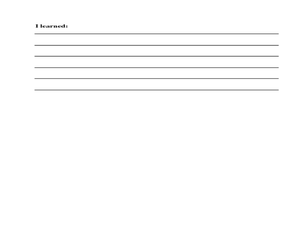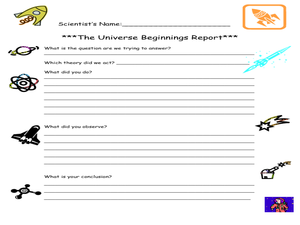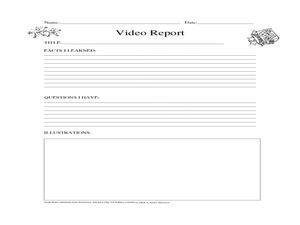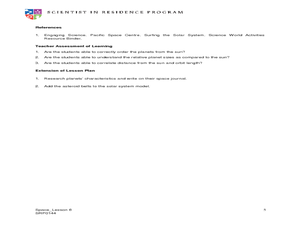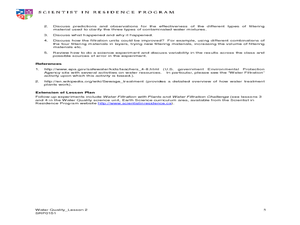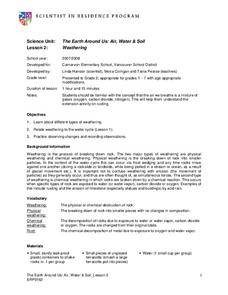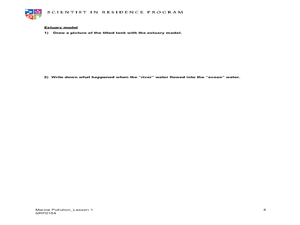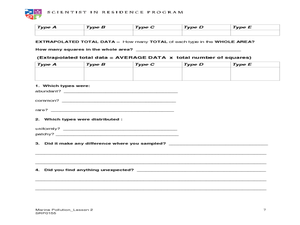Curated OER
Density and Mass
Students experiment to find which liquids are more dense. In this density and mass instructional activity, students predict and then test objects to observe and measure their density. students observe which items sink and float....
Curated OER
Mixtures of Matter
Students experiment with mixtures of matter. In this matter lesson plan, students investigate which liquids form a solution when mixed together and which do not. Students also identify which solids can be separated from matter.
Curated OER
Mixtures of Matter
Young scholars experiment with solids and liquids. In this mixtures of matter instructional activity, students combine matter to form solutions. Young scholars hypothesize, test, and analyze the data to draw conclusions. The...
Curated OER
Solutions and Suspensions
Students explore matter by conducting an in class demonstration. In this liquid mixture lesson, students identify the difference between a solution in which a solid dissolves into liquid, and a suspension where the solid doesn't dissolve...
Curated OER
Introduction to the Scientific Method
Students participate in an experiment and learn to record it using the scientific method. For this biodegradable plastics lesson, students follow the scientific method to complete an inquiry. Students complete an experiment with a...
Curated OER
Introduction to the Scientific Method
Students recognize and follow the steps of the scientific method to complete an experiment. In this scientific method lesson, students use inquiry tools to measure objects. Students record their data.
Curated OER
What is Plastic?
Students experiment with plastics. In this what is plastic lesson, students make a simple polymer and discuss recycling. Students identify various types of plastics.
Curated OER
Bioplastics
Students define bioplastics and identify its uses. In this bioplastics lesson, students compare and contrast styrofoam to starch peanuts after careful examination. Students understand what biodegradeable means.
Curated OER
Space: The Universe As We Know It!
Students simulate the Big Bang. In this lesson on the origin of our universe, students role play to show how the Big Bang explosion may have created our universe.
Curated OER
How Hot and How Big?
Students explore star color and size. In this space science lesson plan, students conduct various inquiry activities to explore how the color of a star affects the amount of heat produced. They also investigate how the color of stars...
Curated OER
Twinkle, Twinkle, Little Star
Learners identify patterns in the stars. In this constellation lesson plan, students simulate constellations using black canisters and patterns. Learners discuss the points on the constellations and how to draw imaginary lines to see the...
Curated OER
Space: Our Star, the Sun, and Its Friends, the Planets
Learners examine the solar system. For this space lesson, students identify the order of the planets and their relative size to the sun. Learners create a scale model of our solar system using a variety of household objects.
Curated OER
pH and Red Cabbage Juice
Students review properties of materials and define what pH tells them about matter. In this pH levels instructional activity, students determine whether materials are acids or bases using indicator substances.
Curated OER
Water Quality: Water Filtration
Students build a water filtration system. In this water quality instructional activity, students work in groups to construct water filtration units that can purify contaminated water. This instructional activity is part of a larger unit...
Curated OER
Water filtration with Plants
Sixth graders explain how soil and plants effect contaminated water in nature. In this filtration instructional activity, 6th graders work in groups to test biofiltration units. Students determine which biofiltration units work...
Curated OER
Water Filtration Challenge
Learners create an all-natural water filtration system. In this lesson on natural water filtration, students build upon prior knowledge to build a filtration unit made of plants, soils, sand, pebbles and rocks that can purify...
Curated OER
Water Cycle
Second graders investigate the water cycle. In this water cycle lesson, 2nd graders discover how the water cycle effects erosion and weathering. Students create their own terrariums to view the water cycle. Students illustrate their...
Curated OER
Weathering
Second graders explore weathering and how the water cycle plays a part in weathering. In this weathering activity, 2nd graders put gravel and sugar cubes in a jar and shake, simulating weathering. Students use the scientific method...
Curated OER
The Earth Around Us: Air, Water & Soil
Second graders explore erosion and find the factors effecting erosion of hillsides. For this erosion lesson, 2nd graders experiment by creating a hillside and simulating rain. Students discuss and record their results...
Curated OER
What is Soil?
Students examine soil. In this earth science lesson, students define and describe weathering and erosion as it relates to soil. Students compare and contrast potting soil with forest soil and complete a science observation worksheet.
Curated OER
Worm Composting
Second graders discuss worm composting. For this decomposition lesson, 2nd graders look at the anatomy of the worm and how it eats food. They have their own worm bin and review what foods can and can not be given to the worms for...
Curated OER
Can Worms See?
Second graders discuss the previously created worm compost and the importance of living creatures to the Environment. For this worm lesson, 2nd graders observe worms and record their sensitivity to light. Students design a petri...
Curated OER
Modeling Estuaries
Students create a model estuary. In this modeling estuaries instructional activity, students identify characteristics and mix water of varying densities. Students form a hypothesis, conduct an experiment, and analyze the results.
Curated OER
Scientific Sampling
Learners take a sample of fish and try to determine how many fish are in the sea. In this scientific sampling instructional activity, students explore the way scientists measure large areas of samples. Learners record the...


